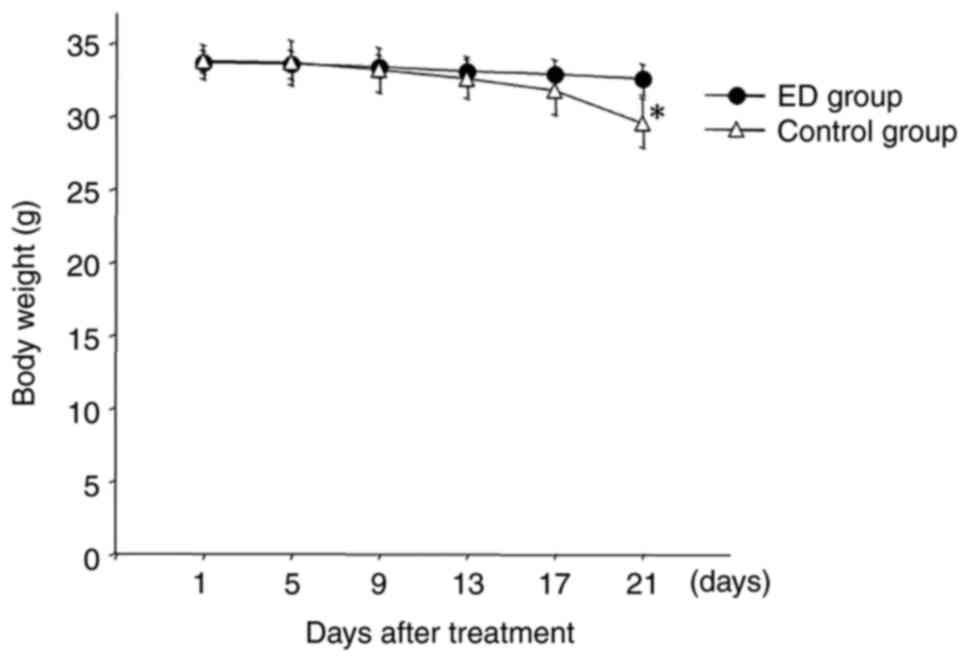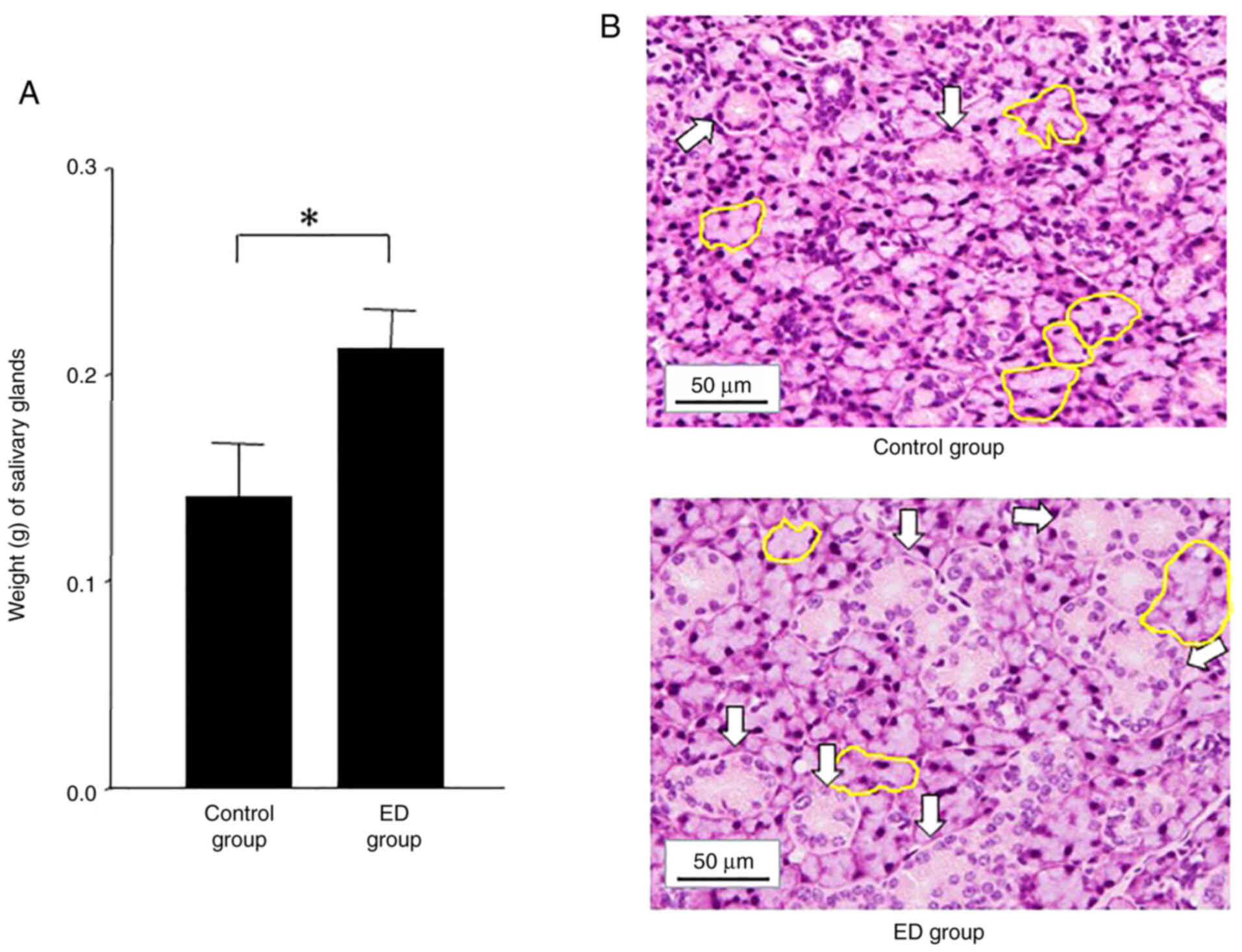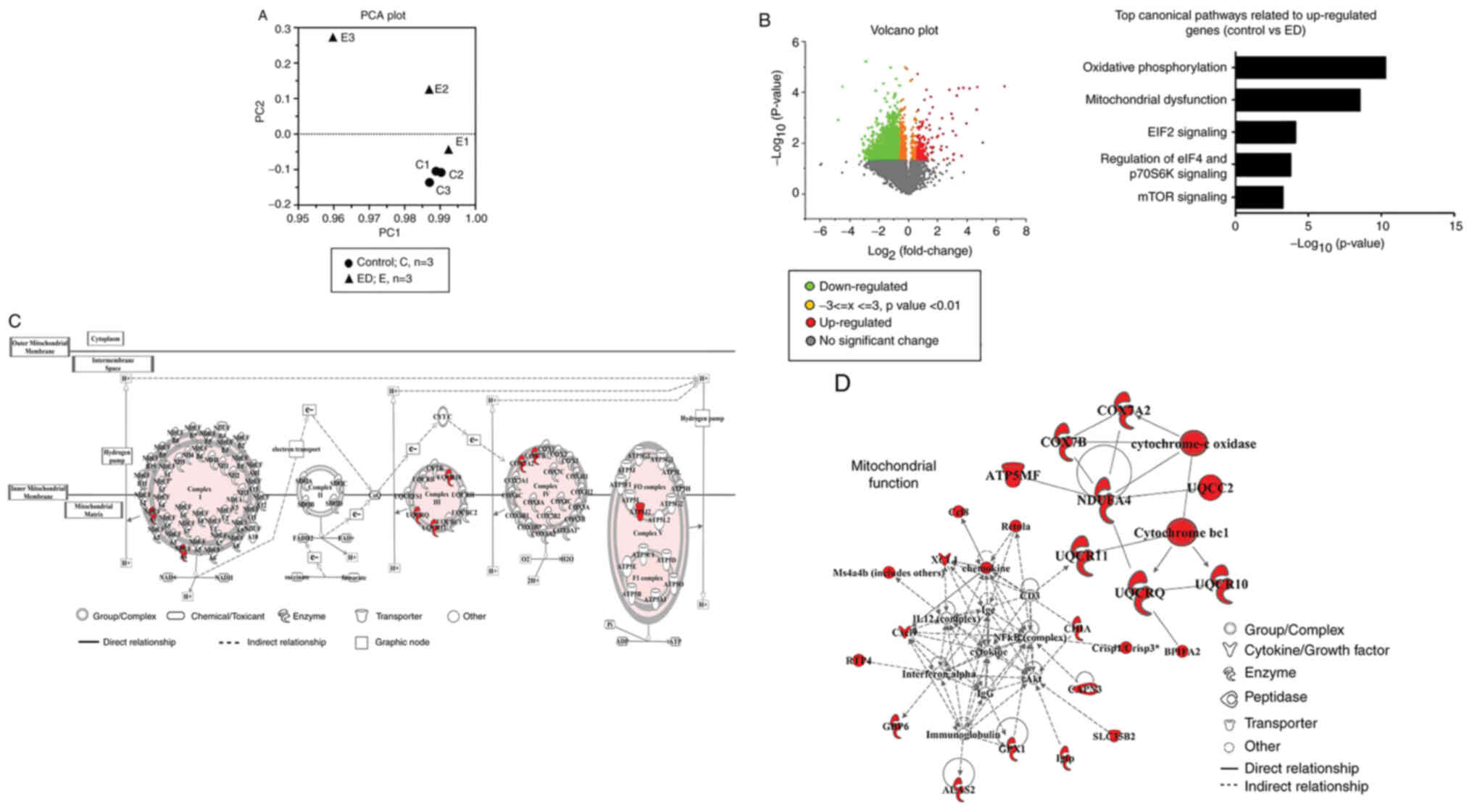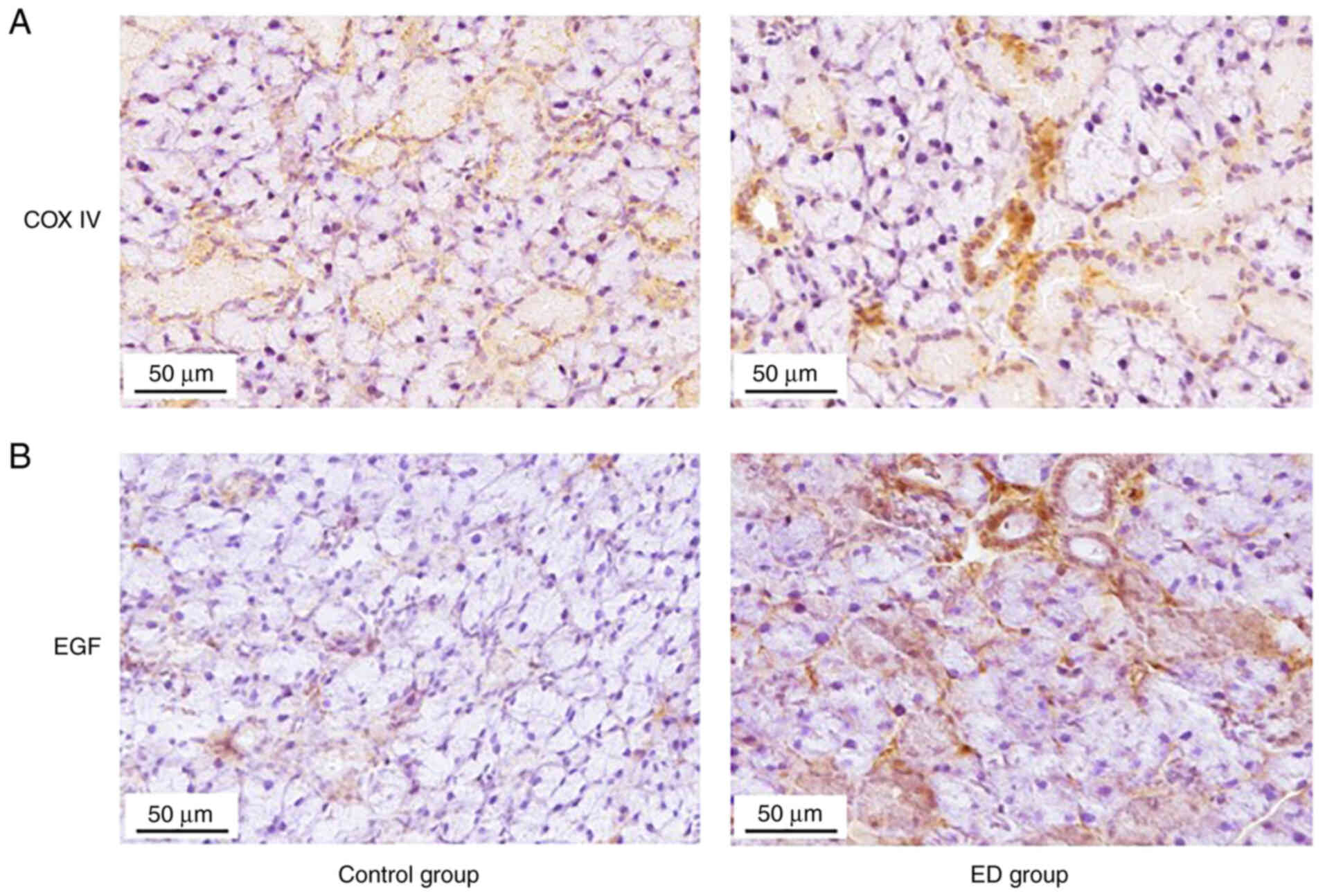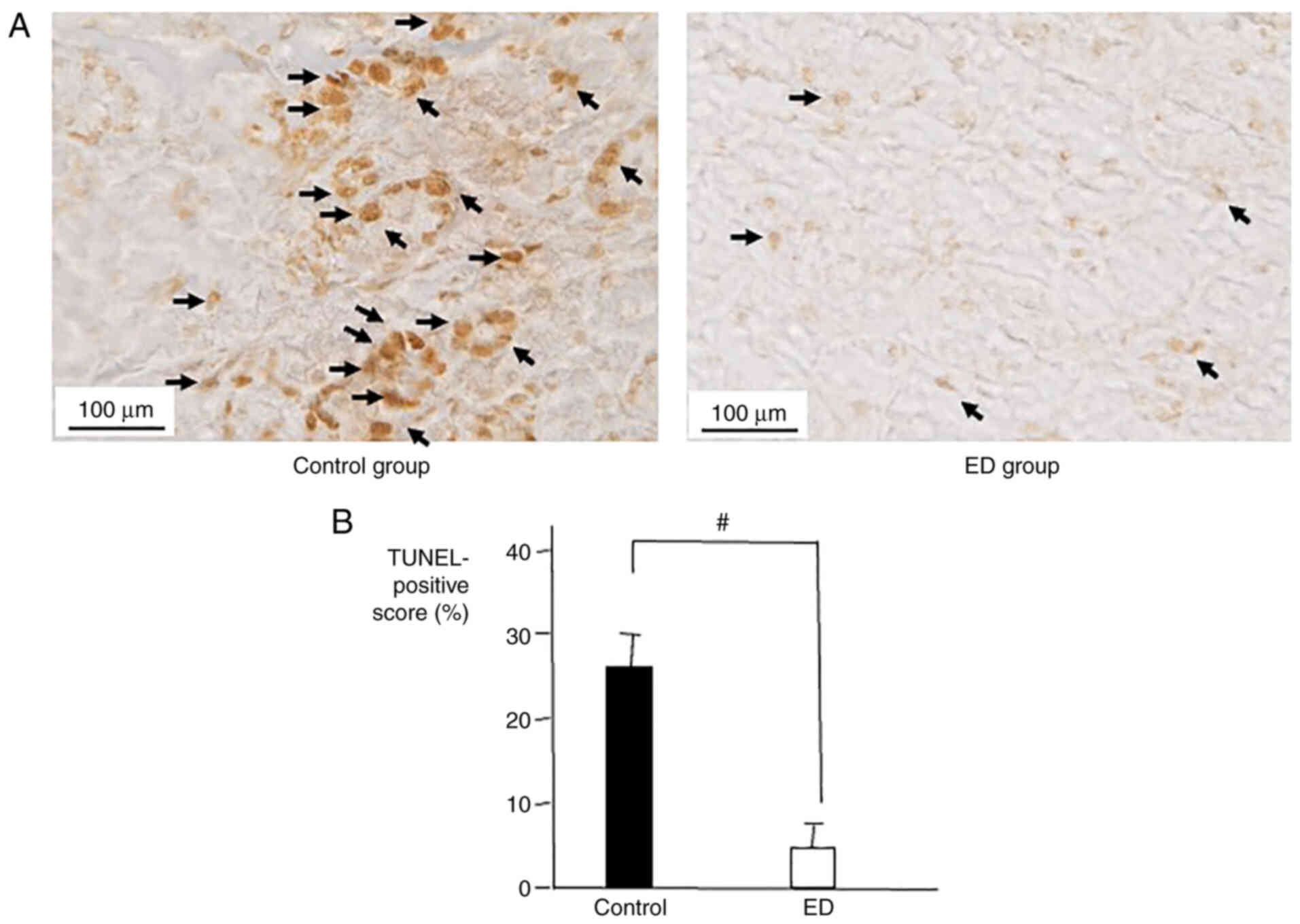|
1
|
Epstein JB, Thariat J, Bensadoun RJ,
Barasch A, Murphy BA, Kolnick L, Popplewell L and Maghami E: Oral
complications of cancer and cancer therapy: From cancer treatment
to survivorship. CA Cancer J Clin. 62:400–422. 2012. View Article : Google Scholar : PubMed/NCBI
|
|
2
|
Pulito C, Cristaudo A, Porta C, Zapperi S,
Blandino G, Morrone A and Stranoet S: Oral mucositis: The hidden
side of cancer therapy. J Exp Clin Cancer Res. 39:2102020.
View Article : Google Scholar : PubMed/NCBI
|
|
3
|
Tanaka Y, Takeuchi H, Nakashima Y, Nagano
H, Ueno T, Tomizuka K, Morita S, Emi Y, Hamai Y, Hihara J, et al:
Effects of an elemental diet to reduce adverse events in patients
with esophageal cancer receiving
docetaxel/cisplatin/5-fluorouracil: A phase III randomized
controlled trial-EPOC 2 (JFMC49-1601-C5). ESMO Open. 6:1002772021.
View Article : Google Scholar : PubMed/NCBI
|
|
4
|
Reyes-Gibby CC, Melkonian SC, Wang J, Yu
RK, Shelburne SA, Lu C, Gunn GB, Chambers MS, Hanna EY, Yeung SJ
and Shete S: Identifying novel genes and biological processes
relevant to the development of cancer therapy-induced mucositis: An
informative gene network analysis. PLoS One. 12:e01803962017.
View Article : Google Scholar : PubMed/NCBI
|
|
5
|
Sayles C, Hickerson SC, Bhat RR, Hall J,
Garey KW and Trivedi MV: Oral glutamine in preventing
treatment-related mucositis in adult patients with cancer: A
systematic review. Nutr Clin Pract. 31:171–179. 2016. View Article : Google Scholar : PubMed/NCBI
|
|
6
|
Lalla RV, Bowen J, Barasch A, Elting L,
Epstein J, Keefe DM, McGuire DB, Migliorati C, Nicolatou-Galitis O,
Peterson DE, et al: MASCC/ISOO clinical practice guidelines for the
management of mucositis secondary to cancer therapy. Cancer.
120:1453–1461. 2014. View Article : Google Scholar : PubMed/NCBI
|
|
7
|
Abdel Moneim AE, Guerra-Librero A, Florido
J, Shen YQ, Fernández-Gil B, Acuña-Castroviejo D and Escames G:
Oral mucositis: Melatonin gel an effective new treatment. Int J Mol
Sci. 18:10032017. View Article : Google Scholar : PubMed/NCBI
|
|
8
|
Kyllo RL and Anadkat MJ: Dermatologic
adverse events to chemotherapeutic agents, part 1: Cytotoxics,
epidermal growth factor receptors, multikinase inhibitors, and
proteasome inhibitors. Semin Cutan Med Surg. 33:28–39. 2014.
View Article : Google Scholar : PubMed/NCBI
|
|
9
|
Keefe DM, Schubert MM, Elting LS, Sonis
ST, Epstein JB, Raber-Durlacher JE, Migliorati CA, McGuire DB,
Hutchins RD and Peterson DE; Mucositis Study Section of the
Multinational Association of Supportive Care in Cancer and the
International Society for Oral Oncology, . Updated clinical
practice guidelines for the prevention and treatment of mucositis.
Cancer. 109:820–831. 2007. View Article : Google Scholar : PubMed/NCBI
|
|
10
|
Peterson DE, Bensadoun RJ and Roila F;
ESMO Guidelines Working Group, : Management of oral and
gastrointestinal mucositis: ESMO clinical recommendations. Ann
Oncol. 20 (Suppl 4):S174–S177. 2009. View Article : Google Scholar
|
|
11
|
Henke M, Alfonsi M, Foa P, Giralt J,
Bardet E, Cerezo L, Salzwimmer M, Lizambri R, Emmerson L, Chen MG
and Berger D: Palifermin decreases severe oral mucositis of
patients undergoing postoperative radiochemotherapy for head and
neck cancer: A randomized, placebo-controlled trial. J Clin Oncol.
29:2815–2820. 2011. View Article : Google Scholar : PubMed/NCBI
|
|
12
|
Bensinger W, Schubert M, Ang KK, Brizel D,
Brown E, Eilers JG, Elting L, Mittal BB, Schattner MA, Spielberger
R, et al: NCCN task force report. Prevention and management of
mucositis in cancer care. J Natl Compr Canc Netw. 6 (Suppl
1):S1–S24. 2008. View Article : Google Scholar : PubMed/NCBI
|
|
13
|
Svanberg A, Ohrn K and Birgegård G: Oral
cryotherapy reduces mucositis and improves nutrition-a randomised
controlled trial. J Clin Nurs. 19:2146–2151. 2010. View Article : Google Scholar : PubMed/NCBI
|
|
14
|
Scully C, Epstein J and Sonis S: Oral
mucositis: A challenging complication of radiotherapy,
chemotherapy, and radiochemotherapy. Part 2: Diagnosis and
management of mucositis. Head Neck. 26:77–84. 2004. View Article : Google Scholar : PubMed/NCBI
|
|
15
|
Yamamoto T, Nakahigashi M, Umegae S,
Kitagawa T and Matsumoto K: Impact of elemental diet on mucosal
inflammation in patients with active Crohn's disease: Cytokine
production and endoscopic and histological findings. Inflamm Bowel
Dis. 11:580–588. 2005. View Article : Google Scholar : PubMed/NCBI
|
|
16
|
Ishikawa T, Yasuda T, Doi T, Okayama T,
Sakamoto N, Gen Y, Dohi O, Yoshida N, Kamada K, Uchiyama K, et al:
The amino acid-rich elemental diet Elental® preserves
lean body mass during chemo- or chemoradiotherapy for esophageal
cancer. Oncol Rep. 36:1093–1100. 2016. View Article : Google Scholar : PubMed/NCBI
|
|
17
|
Yamamoto T, Nakahigashi M, Saniabadi AR,
Iwata T, Maruyama Y, Umegae S and Matsumoto K: Impacts of long-term
enteral nutrition on clinical and endoscopic disease activities and
mucosal cytokines during remission in patients with Crohn's
disease: A prospective study. Inflamm Bowel Dis. 13:1493–1501.
2007. View Article : Google Scholar : PubMed/NCBI
|
|
18
|
Yamamoto T, Nakahigashi M, Umegae S,
Kitagawa T and Matsumoto K: Impact of long-term enteral nutrition
on clinical and endoscopic recurrence after resection for Crohn's
disease: A prospective, non-randomized, parallel, controlled study.
Aliment Pharmacol Ther. 25:67–72. 2007. View Article : Google Scholar : PubMed/NCBI
|
|
19
|
Fukui T, Itoh Y, Orihara M, Yoshizawa K,
Takeda H, Kawada S and Yoshioka T: Elental prevented and reduced
oral mucositis during chemotherapy in patients esophageal cancer.
Gan To Kagaku Ryoho. 38:2597–2601. 2011.(In Japanese). PubMed/NCBI
|
|
20
|
Ogata Y, Takeuchi M, Ishibashi N, Kibe S,
Takahashi K, Uchida S, Murakami N, Yahara T and Shirouzu K:
Efficacy of Elental on prevention for chemotherapy-induced oral
mucositis in colorectal cancer patients. Gan To Kagaku Ryoho.
39:583–587. 2012.(In Japanese). PubMed/NCBI
|
|
21
|
Harada K, Ferdous T, Horinaga D, Uchida K,
Mano T, Mishima K, Park S, Hanazawa H, Takahashi S, Okita A, et al:
Efficacy of elemental diet on prevention for
chemoradiotherapy-induced oral mucositis in patients with oral
squamous cell carcinoma. Support Care Cancer. 24:953–959. 2016.
View Article : Google Scholar : PubMed/NCBI
|
|
22
|
Harada K, Minami H, Ferdous T, Kato Y,
Umeda H, Horinaga D, Uchida K, Park SC, Hanazawa H, Takahashi S, et
al: The Elental® elemental diet for
chemoradiotherapy-induced oral mucositis: A prospective study in
patients with oral squamous cell carcinoma. Mol Clin Oncol.
10:159–167. 2019.PubMed/NCBI
|
|
23
|
Hüttemann M, Helling S, Sanderson TH,
Sinkler C, Samavati L, Mahapatra G, Varughese A, Lu G, Liu J,
Ramzan R, et al: Regulation of mitochondrial respiration and
apoptosis through cell signaling: Cytochrome c oxidase and
cytochrome c in ischemia/reperfusion injury and inflammation.
Biochim Biophys Acta. 1817:598–609. 2012. View Article : Google Scholar : PubMed/NCBI
|
|
24
|
Bikas A, Jensen K, Patel A, Costello J,
Reynolds SM, Mendonca-Torres MC, Thakur S, Klubo-Gwiezdzinska J,
Ylli D, Wartofsky L, et al: Cytochrome C oxidase subunit 4 (COX4):
A potential therapeutic target for the treatment of medullary
thyroid cancer. Cancers (Basel). 12:25482020. View Article : Google Scholar : PubMed/NCBI
|
|
25
|
Vogt S, Ruppert V, Pankuweit S, Paletta
JPJ, Rhiel A, Weber P, Irqsusi M, Cybulski P and Ramzan R:
Myocardial insufficiency is related to reduced subunit 4 content of
cytochrome c oxidase. J Cardiothorac Surg. 13:952018. View Article : Google Scholar : PubMed/NCBI
|
|
26
|
Li Y, Park JS, Deng JH and Bai Y:
Cytochrome c oxidase subunit IV is essential for assembly and
respiratory function of the enzyme complex. J Bioenerg Biomembr.
38:283–291. 2006. View Article : Google Scholar : PubMed/NCBI
|
|
27
|
Cano Sanchez M, Lancel S, Boulanger E and
Neviere R: Targeting oxidative stress and mitochondrial dysfunction
in the treatment of impaired wound healing: A systematic review.
Antioxidants (Basel). 7:982018. View Article : Google Scholar : PubMed/NCBI
|
|
28
|
Hoffmann RF, Jonker MR, Brandenburg SM, de
Bruin HG, Ten Hacken NHT, van Oosterhout AJM and Heijink IH:
Mitochondrial dysfunction increases pro-inflammatory cytokine
production and impairs repair and corticosteroid responsiveness in
lung epithelium. Sci Rep. 9:150472019. View Article : Google Scholar : PubMed/NCBI
|
|
29
|
Saegusa Y, Ichikawa T, Iwai T, Goso Y,
Ikezawa T, Nakano M, Shikama N, Saigenji K and Ishihara K: Effects
of acid antisecretory drugs on mucus barrier of the rat against
5-fluorouracil-induced gastrointestinal mucositis. Scand J
Gastroenterol. 43:531–537. 2008. View Article : Google Scholar : PubMed/NCBI
|
|
30
|
Stempniewicz A, Ceranowicz P and Warzecha
Z: Potential therapeutic effects of gut hormones, ghrelin and
obestatin in oral mucositis. Int J Mol Sci. 20:15342019. View Article : Google Scholar : PubMed/NCBI
|
|
31
|
Van Leeuwen SJM, Proctor GB, Laheij AMGA,
Potting CMJ, Smits O, Bronkhorst EM, Hazenberg MD, Haverman TM,
Brennan MT, Von Bültzingslöwen I, et al: Significant salivary
changes in relation to oral mucositis following autologous
hematopoietic stem cell transplantation. Bone Marrow Transplant.
56:1381–1390. 2021. View Article : Google Scholar : PubMed/NCBI
|
|
32
|
Dumbrigue HB, Sandow PL, Nguyen KH and
Humphreys-Beher MG: Salivary epidermal growth factor levels
decrease in patients receiving radiation therapy to the head and
neck. Oral Surg Oral Med Oral Pathol Oral Radiol Endod. 89:710–716.
2000. View Article : Google Scholar : PubMed/NCBI
|
|
33
|
Harrison T, Bigler L, Tucci M, Pratt L,
Malamud F, Thigpen JT, Streckfus C and Younger H: Salivary sIgA
concentrations and stimulated whole saliva flow rates among women
undergoing chemotherapy for breast cancer: An exploratory study.
Spec Care Dentist. 18:109–112. 1998. View Article : Google Scholar : PubMed/NCBI
|
|
34
|
Brand HS, Ligtenberg AJ and Veerman EC:
Saliva and wound healing. Monogr Oral Sci. 24:52–60. 2014.
View Article : Google Scholar : PubMed/NCBI
|
|
35
|
McCarthy GM, Awde JD, Ghandi H, Vincent M
and Kocha WI: Risk factors associated with mucositis in cancer
patients receiving 5-fluorouracil. Oral Oncol. 34:484–490. 1998.
View Article : Google Scholar : PubMed/NCBI
|
|
36
|
Epstein JB, Tsang AH, Warkentin D and Ship
JA: The role of salivary function in modulating
chemotherapy-induced oropharyngeal mucositis: A review of the
literature. Oral Surg Oral Med Oral Pathol Oral Radiol Endod.
94:39–44. 2002. View Article : Google Scholar : PubMed/NCBI
|
|
37
|
QIAGEN, . Online Ingenuity Knowledge
Base-Articles. https://qiagen.secure.force.com/KnowledgeBase/KnowledgeIPAPage?id=kA41i000000L5sBFebruary
27–2022
|
|
38
|
Wie SM, Wellberg E, Karam SD and Reyland
ME: Tyrosine kinase inhibitors protect the salivary gland from
radiation damage by inhibiting activation of protein kinase C-δ.
Mol Cancer Ther. 16:1989–1998. 2017. View Article : Google Scholar : PubMed/NCBI
|
|
39
|
Kawashima R, Fujimaki M, Ikenoue Y, Danjo
K, Koizumi W and Ichikawa T: Influence of an elemental diet on
5-fluorouracil-induced morphological changes in the mouse salivary
gland and colon. Support Care Cancer. 24:1609–1616. 2016.
View Article : Google Scholar : PubMed/NCBI
|
|
40
|
Fujiwara R, Harada K, Ferdous T and
Mishima K: Amino acids may have protective effects on salivary
glands of 5-FU-administered mice. In Vivo. 36:198–205. 2022.
View Article : Google Scholar : PubMed/NCBI
|
|
41
|
Jensen SB, Pedersen AM, Reibel J and
Nauntofte B: Xerostomia and hypofunction of the salivary glands in
cancer therapy. Support Care Cancer. 11:207–225. 2003. View Article : Google Scholar : PubMed/NCBI
|
|
42
|
Harada K, Ferdous T, Kobayashi H and
Ueyama Y: Elemental diet accelerates the recovery from oral
mucositis and dermatitis induced by 5-fluorouracil through the
induction of fibroblast growth factor 2. Integr Cancer Ther.
17:423–430. 2018. View Article : Google Scholar : PubMed/NCBI
|
|
43
|
Harada K, Takenawa T, Ferdous T, Mizukami
Y and Mishima K: Elemental diet directly affects
chemotherapy-induced dermatitis and raw wound areas. Mol Clin
Oncol. 13:209–215. 2020. View Article : Google Scholar : PubMed/NCBI
|
|
44
|
Hao YH, Zhang J, Wang H, Wang HY, Dong J,
Xu XP, Yao BW, Wang LF, Zhou HM, Zhao L and Peng RY: HIF-1α
regulates COXIV subunits, a potential mechanism of self-protective
response to microwave induced mitochondrial damages in neurons. Sci
Rep. 8:104032018. View Article : Google Scholar : PubMed/NCBI
|















